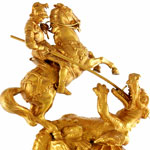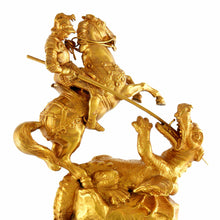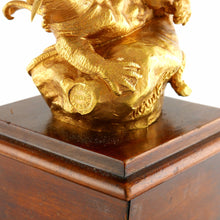George and the Dragon Cavalry Trophy, 1912
Adding product to your cart
Overall height: 21cm (8.25in)
Gilt bronze model of St George slaying the dragon signed ‘T. Curts fec’[it], the pseudonym of sculptor Carl Kauba, and foundry stamped ‘Copyright Thenn Vienna’, mounted on a stepped mahogany base applied with a gilt metal plaque inscribed ‘Kav[vallerie] / Ubungen / Kolbuszowa / 1912.’ (Cavalry Exercises, Kolbusowa 1912); the underside further bearing the trade label of the Austrian Imperial Court supplier G. Edlauer, Plankengasse 3, Vienna.
Read more
The present model commemorates Austro-Hungarian cavalry exercises played out at Kolbuszowa, a small town in modern day southeast Poland that a little over a century ago it was part of Galicia, a crown land of the Austro-Hungarian empire bordering Imperial Russia. Galicia with its wide open plains was considered ideal cavalry country and was consequently where a large proportion of the Austro-Hungarian Monarchy’s fifty-eight cavalry regiments were stationed. Ignoring the lessons of the then recent Anglo-Boer War and Russo-Japanese War, aristocratic officers of the Dual Monarchy clung to the traditionalist belief that speed of movement, bravery and strict discipline would overcome any advantage that the enemy may enjoy. Just two years after the present model was used to invoke such qualities, the Austro-Hungarian cavalry, after initial successes against invading Russian forces, was decisively beaten by artillery and machine guns at the Battle of Lemberg (23 August-11 September 1914).
The sculptor Carl Kauba (1865-1922), who worked under the pseudonyms of T. Curts, and Karl Thenn, was the son of a Viennese shoemaker, and trained at the Vienna Academy of Fine Arts and in Paris in 1886. He produced a wide variety of intricate figurative bronzes for the Viennese luxury goods market. St. George and the Dragon was a subject he visited several times - one such example, designed for use as a rare car mascot, being a nickel plated bronze of a sword wielding St. George vanquishing the dragon. Arguably the present design is more cohesive. Here St. George’s flexed lance skewers the dragon’s neck illustrating perhaps that fleeting moment of tension felt by a Hungarian Uhlan when his lance found its mark.
Kauba also had a fascination with the American West, a subject that gave free rein to his virtuosity. Red Indians, cowboys, roughriders and cavalry troopers became the subjects of his output; as were a range of metamorphic sculptures known as ‘Naughties’ that passed as racy in turn of the century Vienna.








